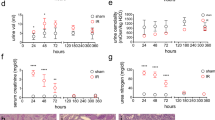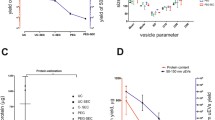Abstract
Purpose
To assess a new and highly specific, but low-cost, easily performed and suitable for large-scale applications method for renal fibrosis (RF) diagnostics.
Methods
Thirty-five RF and twenty non-RF patients were enrolled in the study. An appropriate polyethylene glycol (PEG) was used to isolate urinary exosomes. The efficiency of isolation process was evaluated by the morphology and size observation, as well as the detection of specific markers (CD63, CD9). The expression level of exosomal miR-29c, miR-21 and the endogenous control snRNA-U6 were detected by qRT-PCR. The diagnostic potency of urinary exosomal miR-29c and miR-21 was estimated by the ROC method. Spearman’s rank-order correlations analysis was used to assess the correlation between the miRNAs and clinical parameters, including pathological index.
Results
PEG-based method for isolation urinary exosome was effective and could be completed with a relatively low-speed centrifugal machine. Exosomal miR-29c and miR-21 were detected in all samples. The analysis of miRNAs in urinary exosomes revealed significant dys-regulation of miR-29c and miR-21 associated with RF. Exosomal miR-29c and miR-21 could predict degree of RF with AUC of 0.8333 and 0.7639 (P < 0.05). Correlation analysis showed that the level of miR-29c had a significant negative relationship with eGFR and the interstitial relative area.
Conclusions
The PEG-based method for isolation urinary exosome is an inexpensive and easily performed approach. The application for cargo miRNA analysis is feasible. Urinary exosomal miR-29c may present a promising diagnostic approach.






Similar content being viewed by others
References
Nogueira A, Pires MJ, Oliveira PA (2017) Pathophysiological mechanisms of renal fibrosis: a review of animal models and therapeutic strategies. In Vivo 31:1
Meng XM, Nikolic-Paterson DJ, Lan HY (2014) Inflammatory processes in renal fibrosis. Nat Rev Nephrol 10:493
Zanotti S, Gibertini S, Curcio M et al (2015) Opposing roles of miR-21 and miR-29 in the progression of fibrosis in Duchenne muscular dystrophy. Biochim Biophys Acta 1852:1451
Roderburg C, Urban GW, Bettermann K et al (2011) Micro-RNA profiling reveals a role for miR-29 in human and murine liver fibrosis. Hepatology 53:209
Fang Yi, Xiaofang Yu, Liu Yong et al (2013) miR-29c is downregulated in renal interstitial fibrosis in humans and rats and restored by HIF-α activation. Am J Physiol Renal Physiol 304:F1274
Qin W, Chung AC, Huang XR et al (2011) TGF-β/Smad3 signaling promotes renal fibrosis by inhibiting miR-29. J Am Soc Nephrol 22:1462
Cushing L, Kuang PP, Qian J et al (2011) miR-29 is a major regulator of genes associated with pulmonary fibrosis. Am J Respir Cell Mol Biol 45:287
Xiao J, Meng XM, Huang XR et al (2012) miR-29 inhibits bleomycin-induced pulmonary fibrosis in mice. Mol Ther 20:1251
Rubiś P, Totoń-Żurańska J, Wiśniowska-Śmiałek S et al (2017) Relations between circulating microRNAs (miR-21, miR-26, miR-29, miR-30 and miR-133a), extracellular matrix fibrosis and serum markers of fibrosis in dilated cardiomyopathy. Int J Cardiol 231:201
Wang G, Kwan BC-H, Lai FM-M et al (2012) Urinary miR-21, miR-29, and miR-93: novel biomarkers of fibrosis. Am J Nephrol 36:412
Lv Lin-Li, Cao Yu-Han, Ni Hai-Feng et al (2013) MicroRNA-29c in urinary exosome/microvesicle as a biomarker of renal fibrosis. Am J Physiol Renal Physiol 305:F1220
Reddy S, Hu DQ, Zhao M et al (2017) miR-21 is associated with fibrosis and right ventricular failure. JCI Insight 2:91625
Loboda A, Sobczak M, Jozkowicz A et al (2016) TGF-β1/Smads and miR-21 in renal fibrosis and inflammation. Mediators Inflamm 2016:8319283
Li CP, Li HJ, Nie J et al (2017) Mutation of miR-21 targets endogenous lipoprotein receptor-related protein 6 and nonalcoholic fatty liver disease. Am J Transl Res 9:715
Li P, Zhao GQ, Chen TF et al (2013) Serum miR-21 and miR-155 expression in idiopathic pulmonary fibrosis. J Asthma 50:960
ZununiVahed S, Omidi Y, Ardalan M et al (2017) Dysregulation of urinary miR-21 and miR-200b associated with interstitial fibrosis and tubular atrophy (IFTA) in renal transplant recipients. Clin Biochem 50:32
Rider MA, Hurwitz SN, Jr DGM (2016) ExtraPEG: a polyethylene glycol-based method for enrichment of extracellular vesicles. Sci Rep 6:23978
Weng Y, Sui Z, Shan Y et al (2016) Effective isolation of exosomes with polyethylene glycol from cell culture supernatant for in-depth proteome profiling. Analyst 141:4640
Radford MG, Donadio JV, Bergstral HE et al (1997) Predicting renal outcome in IgA nephropathy. Jan SocNephrol 8:199
Mizuguchi Y, Miyajima A, Kosaka T et al (2004) Atorvastatin ameliorates renal tissue damage in unilateral ureteral obstruction. Urol 172:2456
Kretzler M (2005) Role of podocytes in focal sclerosis: defining the point of no return. J Am Soc Nephrol 16:2830
Raij L, Azars S, Keane W (1984) Mesangial immune injury, hypertension, and progressive glomerular damage in dahl rats. Kidney Int 43:137
Miranda KC, Bond DT, McKee M et al (2010) Nucleic acids within urinary exosomes/microvesicles are potential biomarkers for renal disease. Kidney Int 78:191
Erdbrügger U, Le TH (2015) Extracellular vesicles in renal diseases: more than novel biomarkers? J Am SocNephrol 27:12
Franzen CA, Blackwell RH, Foreman KE et al (2016) Urinary exosomes: the potential for biomarker utility, intercellular signaling and therapeutics in urological malignancy. J Urol 195:1331
Dear JW, Street JM, Bailey MA (2013) Urinary exosomes: a reservoir for biomarker discovery and potential mediators of intrarenal signalling. Proteomics 13:1572
Beringer PM, Hidayat L, Heed A et al (2009) GFR estimates using cystatin C are superior to serum creatinine in adult patients with cystic fibrosis. J Cyst Fibros 8:19
Glowacki F, Savary G, Gnemmi V et al (2013) Increased circulating miR-21 levels are associated with kidney fibrosis. PLoS ONE 8(2):e58014
Jeppesen DK, Hvam ML, Primdahl-Bengtson B et al (2014) Comparative analysis of discrete exosome fractions obtained by differential centrifugation. J Extracell Vesicles 3:25011
Tauro BJ, Greening DW, Mathias RA et al (2013) Two distinct populations of exosomes are released from LIM1863 colon carcinoma cell-derived organoids. Mol Cell Proteomics 12(3):587–598
Acknowledgements
Supported by the School Foundation of Chengdu University of Traditional Chinese Medicine (Project No. CGPY1601) and key experimental technical items of Chengdu University of Traditional Chinese Medicine (SYZD2017002).
Author information
Authors and Affiliations
Corresponding author
Ethics declarations
Conflict of interest
The authors declare that they have no competing interests.
Ethical standard
All studies were performed according to the ethical standards of the institutional and national research committee and with the 1964 Helsinki Declaration and its later amendments or comparable ethical standards. All the participators were informed of the study and signed the informed consent form.
Informed consent
Informed consent was obtained from all individual participants included in the study.
Rights and permissions
About this article
Cite this article
Lv, Cy., Ding, Wj., Wang, Yl. et al. A PEG-based method for the isolation of urinary exosomes and its application in renal fibrosis diagnostics using cargo miR-29c and miR-21 analysis. Int Urol Nephrol 50, 973–982 (2018). https://doi.org/10.1007/s11255-017-1779-4
Received:
Accepted:
Published:
Issue Date:
DOI: https://doi.org/10.1007/s11255-017-1779-4




